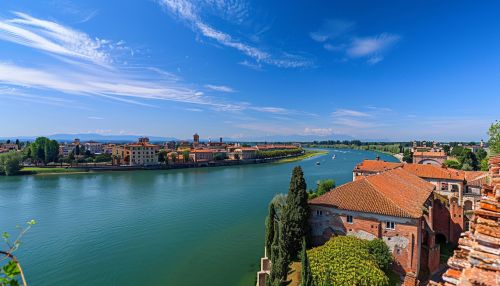Mantua
History
Mantua, known in Italian as Mantova, is a city in the Lombardy region of northern Italy. It is renowned for its significant historical and cultural heritage. The city’s origins date back to the Etruscan period, around the 6th century BCE. Mantua was later influenced by the Romans, who established it as a colony in 214 BCE. The city’s strategic location on the Mincio River contributed to its development as a vital trade and military center.
During the Middle Ages, Mantua was ruled by various noble families, including the Bonacolsi and the Gonzaga. The Gonzaga family, who took control in 1328, played a crucial role in transforming Mantua into a cultural and artistic hub during the Renaissance. Under the Gonzaga rule, the city saw the construction of numerous palaces, churches, and public buildings, many of which still stand today.


Geography and Climate
Mantua is situated in the Po Valley, surrounded by three artificial lakes created in the 12th century as a defense mechanism. These lakes are Lago Superiore, Lago di Mezzo, and Lago Inferiore. The city’s geography is characterized by its flat terrain and proximity to the Mincio River, which flows into the Po River.
The climate in Mantua is classified as humid subtropical (Cfa) according to the Köppen climate classification. The city experiences hot, humid summers and mild, damp winters. Precipitation is relatively evenly distributed throughout the year, with occasional fog during the winter months.
Architecture and Urban Planning
Mantua is renowned for its well-preserved Renaissance architecture. The city’s urban layout reflects its historical development, with a mix of medieval, Renaissance, and Baroque elements. Key architectural landmarks include the Palazzo Ducale, the Palazzo Te, and the Basilica of Sant'Andrea.
Palazzo Ducale
The Palazzo Ducale, or Ducal Palace, is a sprawling complex that served as the residence of the Gonzaga family. It comprises several interconnected buildings, courtyards, and gardens. Notable features include the Camera degli Sposi, adorned with frescoes by Andrea Mantegna, and the Hall of Mirrors.
Palazzo Te
Palazzo Te is a masterpiece of Mannerist architecture designed by Giulio Romano. Built between 1524 and 1534, it served as a pleasure palace for Federico II Gonzaga. The palace is famous for its elaborate frescoes, including the Sala dei Giganti and the Sala di Amore e Psiche.
Basilica of Sant'Andrea
The Basilica of Sant'Andrea, designed by Leon Battista Alberti, is a prime example of Renaissance ecclesiastical architecture. Construction began in 1472 and was completed in the 18th century. The basilica houses the relic of the Precious Blood, believed to be the blood of Christ collected by the Roman centurion Longinus.
Culture and Arts
Mantua has a rich cultural heritage, particularly in the fields of music, literature, and visual arts. The city was a significant center of the Italian Renaissance, attracting artists, musicians, and writers.
Music
Mantua played a pivotal role in the development of early opera. The city was home to Claudio Monteverdi, who composed his groundbreaking opera "L'Orfeo" in 1607. The Gonzaga court was a major patron of the arts, supporting musicians and composers.
Literature
Mantua is associated with several notable literary figures. The Roman poet Virgil was born near Mantua in 70 BCE. The city also features prominently in William Shakespeare's play "Romeo and Juliet," where it serves as Romeo's place of exile.
Visual Arts
The Gonzaga family’s patronage extended to the visual arts, commissioning works from renowned artists such as Andrea Mantegna, Giulio Romano, and Peter Paul Rubens. The city’s museums and galleries house an impressive collection of Renaissance and Baroque art.
Economy
Mantua’s economy has historically been based on agriculture, trade, and manufacturing. The fertile lands of the Po Valley support the cultivation of crops such as rice, maize, and sugar beets. The city also has a tradition of textile production, particularly silk and wool.
In recent years, Mantua has diversified its economy, with a growing emphasis on tourism and cultural industries. The city’s rich historical and architectural heritage attracts visitors from around the world, contributing significantly to the local economy.
Education and Research
Mantua is home to several educational institutions, including the University of Mantua, which offers programs in various fields of study. The city also hosts numerous research centers and cultural institutions, such as the Mantua Academy of Sciences, Letters, and Arts.
Transportation
Mantua is well-connected by road, rail, and waterways. The city’s railway station provides links to major Italian cities, including Milan, Verona, and Bologna. The A22 motorway connects Mantua to the national highway network, facilitating road transport.
The Mincio River and the artificial lakes surrounding the city offer opportunities for water transport and recreational activities. Mantua’s public transportation system includes buses and taxis, providing convenient options for local travel.
Demographics
As of the latest census, Mantua has a population of approximately 50,000 residents. The city’s demographic profile reflects a mix of age groups, with a significant proportion of elderly residents. Mantua also has a diverse population, with immigrants from various countries contributing to the city’s cultural mosaic.
Notable Events
Mantua hosts several annual events that celebrate its cultural and historical heritage. These include the Mantua Literature Festival, the Mantua Chamber Music Festival, and the Palio di San Secondo, a traditional medieval festival.
